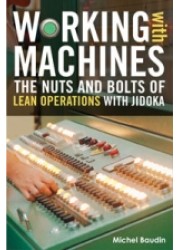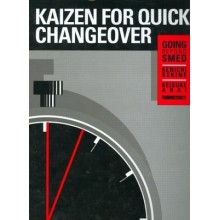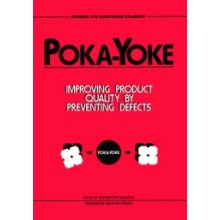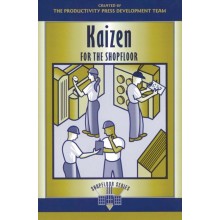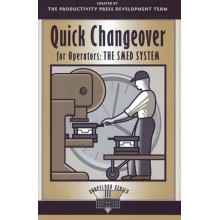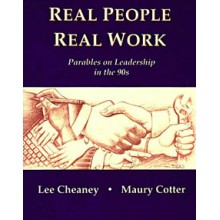Your shopping cart is empty!
Welcome visitor you can login or create an account
Working with Machines : The Nuts and Bolts of Lean Operations with Jidoka
Our Price: £47.99
Quantity:
-
Add to Compare
In Working with Machines: The Nuts and Bolts of Lean Operations With Jidoka, author Michel Baudin explains how performance differences that can be observed between factories are due to the way people use the machines -- from the human interfaces of individual machines to the linking of machines into cells, the management of monuments and common services, autonomation, maintenance, and production control.
This compelling book:
Emphasizes the importance of the "Jidoka" pillar of the Toyota Production System, which is engineering the way people work with machines.
Deals with the art of bringing groups of machines together into "cells."
Addresses the problematic issues associated with "monuments" - those machines that provide services for production lines across a broad variety of products, but cannot be organized into cells.
Compares automation as it has been developed in the US, as a stand-alone discipline with a lean manufacturing approach, to the management of automated systems implemented before a plant started its lean conversion.
This book provides manufacturing managers and engineers, lean champions and consultants with strategies and tools to make the technical and managerial decisions that turn working with machines into a lasting business success.
For More Details, Please Check the Contents:
This compelling book:
Emphasizes the importance of the "Jidoka" pillar of the Toyota Production System, which is engineering the way people work with machines.
Deals with the art of bringing groups of machines together into "cells."
Addresses the problematic issues associated with "monuments" - those machines that provide services for production lines across a broad variety of products, but cannot be organized into cells.
Compares automation as it has been developed in the US, as a stand-alone discipline with a lean manufacturing approach, to the management of automated systems implemented before a plant started its lean conversion.
This book provides manufacturing managers and engineers, lean champions and consultants with strategies and tools to make the technical and managerial decisions that turn working with machines into a lasting business success.
For More Details, Please Check the Contents:
Part I: Human-Machine interfaces
Chapter 1: Using machine controls
Chapter 1: Using machine controls
performing steps on machines
Unloding and loading
Pressing the right button
Monitoring and exception handling
Usability Engineering Principles
Chapter 2: Performing operations on machines
Performing Operations
Sequencing Constraints
Natural Mappings
From Process-centered to result-centered interfaces
Chapter 3: Understanding the process
Machines used at work versus everyday life
Machines used at work versus everyday life
Categories of machine processes
How much do the operators need to know?
The example of Supttering
How Operators Learn
Chapter 4: Programming machines
Impact of machine programmability
Impact of machine programmability
Common features of programmable controllers
Impact of Programmability on shop floor
Characteristics of machine programs
Who should program machine?
Process programs as tangible assect
Part II: Machine cells
Chapter 5: Cellular manufacturing with machines
Lean manufacturing cells with machines
Examples of machine cells
Defining a lean manufacturing cell
Issues with machine cells
Alternative meanings of the word "Cell"
Chapter 6: Design and implementation of a machine cell
About cell design and implementation
About cell design and implementation
Project Planning and project phases
Analysis and design
Equipment installation
Cell startup and finishing
Chapter 7: From operator job design to task assignment
Operator job design
Operator job design
Related charts
Daily task assignments
Chapter 8: Cell automation and chaku-chaku line
What is a chaku-chaku lines
What is a chaku-chaku lines
Detailed features of chaku-chaku lines
Multiple cells in one big room
Operators in chaku-chaku lines
Chaku-chaku line implementation
Chapter 9: Grouping cells into focuses factories
Cells versus focused factories
Cells versus focused factories
A failed cellularization example
The better way
A general approach
PART III Common services and monuments
Chapter 10: Working with monuments
What is a monument?
What is a monument?
What is wrong with monuments?
What to do about monuments
Examples of monuments
Chapter 11: Setup time reduction
Setup time reduction, monuments, and flexible lines
Setup times for individual machines lines
SMED
Setup time reduction management
Outline of a setup time reduction project
Changeover time analysis of a machine
General principles for esternal setup tasks
General principles for externalizing internal setup tasks
General principles for improving internal tasks
PART IV Automation
Chapter 12 The lean approach to automation
Is lean manufacturing anti-automation?
Jidoka, autonomation, and automation
The seven steps of automation for machining
Underlying Principles
Chapter 13 lmproving legacy automated systems
What are legacy systems?
What are legacy systems?
Legacy automated systems in maachining
Increasing availability
Routime operation
Staring the machine
Periodic actions
Part V: Machine maintenance
Chapter 14: Machine and facilities maintenance
Chapter 14: Machine and facilities maintenance
About mantenance
The economics of maintenance
Participants in the maintenance business
Balance between planned and unplanned activities
Preventive maintenance productivity
Failures and microstoppages
Chapter 15: Improving maintenance
Straegies for maintenance improvement
Straegies for maintenance improvement
Reliability-ecntered maintenance (RCM)
Total productive maintenance(TPM)
Maintenance organization
Chapter 16: Maintenance information systems
Computer systems for maintenance
Computer systems for maintenance
Dignosis and failure analysis
Administration, documentation, and paperwork
Chapter 17: Overall Equipment Effectiveness (OEE)
Is faster better?
Is faster better?
OEE as a machine Performsance indicator
OEE calculations
OEE analysis and machine performance improvement
Approprate and inappropriate use of OEE to improve machine performance
Where should you go from here?
Bibliography
Bibliography
Books about machining
Books on usability engineering
Industrial engineering
Operators job design in cells
Chaku-chaku Lines
Focuses factories
Setup time reduction Automation
Maintenance
Write a review
Your Name:Your Review: Note: HTML is not translated!
Rating: Bad Good
Enter the code in the box below:
Price subject to change without notice
Copyright © 2014 Engineering Standards Bureau. All Rights Reserved.
Developed By Zoom Into Web
Copyright © 2014 Engineering Standards Bureau. All Rights Reserved.
Developed By Zoom Into Web


